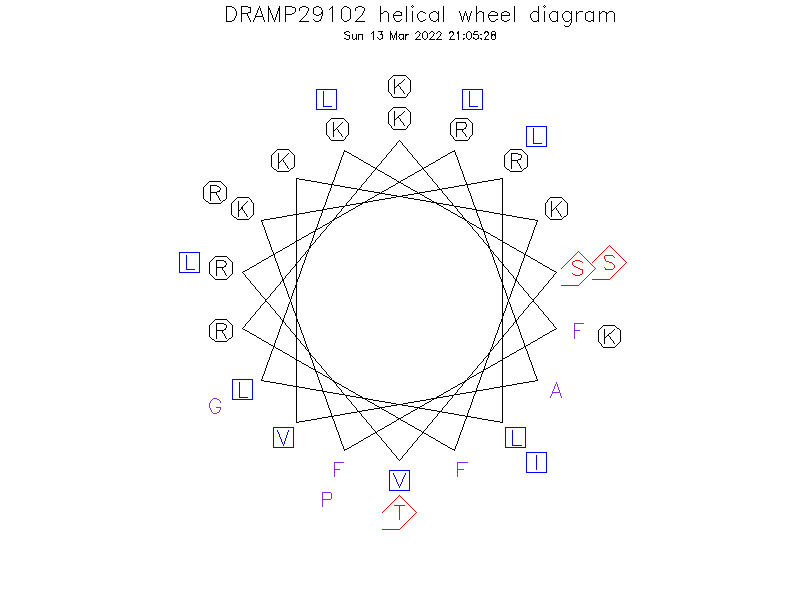General Information
-
DRAMP ID
- DRAMP29102
-
Peptide Name
- Hc-CATH
-
Source
- Hydrophis cyanocinctus
-
Family
- Not found
-
Gene
- Not found
-
Sequence
- KFFKRLLKSVRRAVKKFRKKPRLIGLSTLL
-
Sequence Length
- 30
-
UniProt Entry
- No entry found
-
Protein Existence
- Not found
Activity Information
-
Biological Activity
- Antimicrobial, Antibacterial,Anti-Gram+, Anti-Gram-, Anti-cancer, Antifungal
-
Target Organism
-
- [Ref.26013823]Gram-negative bacteria:Escherichia coli ATCC 25922(MIC=2.34 µg/ml); Escherichia coli ATCC 25922(400 Mm NaCl,MIC=4.69 µg/ml); Escherichia coli 1(MIC=2.34 µg/ml);Escherichia coli 2(MIC=2.34 µg/ml); Escherichia coli 3(MIC=2.34 µg/ml); Escherichia coli 4(MIC=9.38 µg/ml); Shigella dysenteriae(MIC=0.59 µg/ml); Klebsiella pneumoniae 1(MIC=37.50 µg/ml); Klebsiella pneumoniae 2(MIC=4.69 µg/ml); Klebsiella pneumoniae 3(MIC=9.38 µg/ml); Klebsiella pneumoniae 4(MIC=9.38 µg/ml); Klebsiella pneumoniae 5(MIC=18.75 µg/ml); Klebsiella pneumoniae 6(MIC=37.50 µg/ml); Klebsiella pneumoniae 7(MIC=37.50 µg/ml); Klebsiella pneumoniae 8(MIC=75.00 µg/ml); Serratia marcescens(MIC>200 µg/ml); Klebsiella oxytoca(MIC=4.69 µg/ml); Proteus vulgaris(MIC>200 µg/ml); Proteus mirabilis(MIC=4.69 µg/ml); Acinetobacter baumannii 1(MIC>200 µg/ml); Acinetobacter baumannii 2(MIC>200 µg/ml); Stenotrophomonas maltophilia(MIC>200 µg/ml); Stenotrophomonas maltophilia 2(MIC=9.38 µg/ml); Pseudomonas aeruginosa ATCC 27853(MIC=18.75 µg/ml); Pseudomonas aeruginosa 1 (MIC=37.50 µg/ml ); Pseudomonas aeruginosa(MIC>200 µg/ml); Salmonella paratyphi A(MIC=4.69 µg/ml);
- Gram-positive bacteria:Staphylococcus aureus ATCC 25923(MIC=4.69 µg/ml); Staphylococcus aureus 1(MIC>200 µg/ml ); Staphylococcus aureus 2(MIC>200 µg/ml ); Staphylococcus aureus 3(MIC>200 µg/ml ); Staphylococcus aureus 4(MIC=4.69 µg/ml); Staphylococcus aureus 5(MIC=4.69 µg/ml); Bacillus cereus(MIC=9.38 µg/ml); Bacillus subtilis(MIC=75.00 µg/ml); Enterococcus faecium(MIC=37.50 µg/ml); Nocardia asteroides(MIC=9.38 µg/ml); Enterococcus faecalis(MIC>200 µg/ml); Staphylococcus epidermidis(MIC>200 µg/ml);
- Fungi:Candida albicans 1(MIC=4.69 µg/ml); Candida albicans 2(MIC=4.69 µg/ml); Candida albicans 3(MIC=4.69 µg/ml); Candida albicans 4(MIC=4.69 µg/ml); Candida albicans 5(MIC=2.34 µg/ml); Candida albicans 6(MIC=2.34 µg/ml); Candida glabrata 1(MIC=2.34 µg/ml); Candida glabrata(MIC>200 µg/ml); Cryptococcus neoformans(MIC>200 µg/ml); Arcyria cinerea(MIC=9.38 µg/ml);
- Pathogenic bacteria:Aeromonas sobria(MIC=2.34 µg/ml); Aeromonas hydrophila(MIC=2.34 µg/ml); Aeromonas veronii(MIC=2.34 µg/ml); Vibrio vulnificus(MIC=4.69 µg/ml ); Vibrio harveyi(MIC=9.38 µg/ml); Vibrio fluvialis(MIC=4.69 µg/ml); Vibrio alginolyticus(MIC=4.69 µg/ml); Vibrio parahaemolyticus(MIC=9.38 µg/ml); Vibrio splendidus(MIC=2.34 µg/ml); Vibrio anguillarum(MIC=18.75 µg/ml); Edwardsiella tarda(MIC=2.34 µg/ml).
-
Hemolytic Activity
-
- [Ref.26013823]5.25% Hemolysis against Human erythrocytes at 200 µg/ml(55.12 μM).
-
Cytotoxicity
-
- [Ref.26013823]4.70% cell death at 200 µg/ml against Human hepatocellular carcinoma HepG2; 3.63% cell death at 200 µg/ml against Human prostate adenocarcinoma PC-3; 1.30% cell death at 200 µg/ml against Mouse fibroblasts L929.
-
Binding Target
- liposomes
Structure Information
-
Linear/Cyclic
- Linear
-
N-terminal Modification
- Free
-
C-terminal Modification
- Free
-
Nonterminal Modifications and Unusual Amino Acids
- None
-
Stereochemistry
- L
-
Structure
- Alpha helix,β-sheet,random coil
-
Structure Description
- The CD spectra in H2O adopts a random-coil conformation. In the membrane-mimetic environments of SDS/H2O solutions (30–120 mm), the secondary structure components of Hc-CATH dissolved in 60 mm SDS/H2O were calculated as 59.9% α-helix, 16% β-sheet, 0% β-turn, and 24% random coil.When dissolved in SDS/H2O solutions with serial concentrations of NaCl (at 0, 100, 200, and 400 mm), the α-helix contents decreased slightly from 59.9 to 33.8% as the NaCl concentration increased. Simultaneously, the contents of the β-turn (0 to 14.9%) and random coil (24 to 30.5%) increased slightly.
-
Helical Wheel Diagram
-
PDB ID
- None
-
Predicted Structure
- There is no predicted structure for DRAMP29102.
Physicochemical Information
-
Formula
- C171H300N52O34
Absent Amino Acids
- CDEHMNQWY
Common Amino Acids
- K
Mass
- 3628.59
PI
- 12.61
Basic Residues
- 12
Acidic Residues
- 0
Hydrophobic Residues
- 13
Net Charge
- +12
-
Boman Index
- -6861
Hydrophobicity
- -0.273
Aliphatic Index
- 113.67
Half Life
-
- Mammalian:1.3 hour
- Yeast:3 min
- E.coli:2 min
Extinction Coefficient Cystines
- 0
Absorbance 280nm
- 0
Polar Residues
- 4
DRAMP29102

Comments Information
Function
- The microbial killing activity of Hc-CATH is executed through the disruption of cell membrane and lysis of bacterial cells. Antimicrobial activity of Hc-CATH in the presence of a high concentration of sodium chlorideIn addition is strong. Hc-CATH exhibited potent anti-inflammatory activity by inhibiting the LPS-induced production of nitric oxide (NO) and pro-inflammatory cytokines such as TNF-α, IL-1β, and IL-6.
Literature Information
- ·Literature 1
-
Title
- Identification and Characterization of the First Cathelicidin from Sea Snakes with Potent Antimicrobial and Anti-inflammatory Activity and Special Mechanism.
-
Pubmed ID
- 26013823
-
Reference
- J Biol Chem. 2015 Jul 3;290(27):16633-52.
-
Author
- Wei L, Gao J, Zhang S, Wu S, Xie Z, Ling G, Kuang YQ, Yang Y, Yu H, Wang Y.

